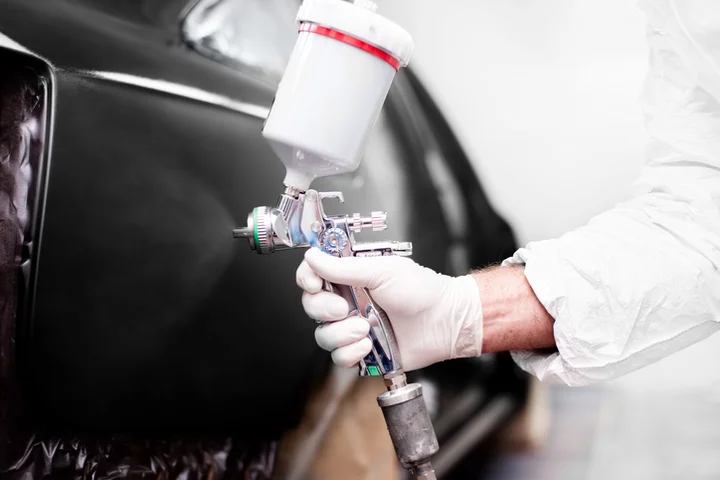Use a paint filter on the pick-up tube at all times. Hard paint fragments from the tin’s edge will drop into the pot; if they weren’t filtered out, they would end up as splats on the panel. While cleaning the gun, the paint filter can be left in place and cleaned. It has a protracted duration.
Loosening the nut at the top will change the pickup tube’s angle. When painting a panel’s top surface, it is set forward to gather the remaining paint. I would turn it the opposite way around to paint underneath a car and avoid having to replenish the pot while it is still halfway full. It makes sense to modify it on a clean gun only, not in the middle of the paint.
Combining Methods
Proper paint mixing is essential for success. Disposable mixing cups are useful yet shockingly inaccurate when using a dipstick. To mix paint, most do-it-yourselfers just follow the manufacturer’s recommended ratio. The paint store can provide advice on the proper paint mixtures. Reusable mixing cups can aid in preserving a respectable degree of precision. The spray gun might affect the precise mixture. The question of what is the best titan gun comes to your mind.
Setup for Spray Gun
Try adjusting the pressure on a traditional siphon pistol to 50 psi and spraying rapidly over some masking paper. Try the same at 45 psi to see if the droplet size has changed and if the coverage rate is still sufficient. 45 psi is a better pressure to utilize if it meets your needs because there won’t be as much overspray. Test 40 psi, and so forth. I seem to spray most of my paint at roughly 40 psi, however this depends on the color and gun. The best pressures are lower ones since they minimize overspray, which might damage other areas of the automobile before you paint them. After adjusting the pressure, check the gun on a test panel; finding balance is crucial.
Guns Method
Maintaining a consistent 6 to 8-inch distance from the panel, keeping the gun at an angle to the panel (to prevent heavy spray on one end of the fan and overspray on the other), and moving the gun at a steady speed in a straight line from side to side are the fundamentals of spraying technique. About 50% of the strokes should overlap one another, with the center of the spray pattern pointing toward the edge of the preceding stroke. You probably have too much paint in the fan’s center if you find that you need to overlap more than that.
A spray gun has two points on its trigger. Squeezing lightly will feed air, but not paint. As the trigger is further depressed, paint is fed in. Release the trigger when the spray gun gets close to the panel’s edge so that the paint flow stops but the airflow continues, then reapply the paint as you move back onto the panel. By doing this, a paintbrush is prevented when the paint is added again. One painting tip from the forum is to use your spare hand to bend the airline to the cannon, which will lower the air pressure in tense regions. By guiding the fan along the panel instead of at right angles, kinking lowers the air pressure and allows the paint to be saved.
Complete the Shot from the Gun
The paint applies with a faint orange peel (picture), then it flows and settles over a short period. The orange peel effect will still be present if the paint is applied too thinly. Paint built up too high might seem fine and flat but would be prone to dripping and sagging. To get a drip-free, flat finish, practicing on an old body panel before spraying the automobile is a helpful approach to honing skills like Titan series guns.
When painting, lighting is crucial, and side lighting is just as significant as overhead lighting. Painting allows for the modification of overlap, travel speed, and distance to the panel since the texture of the paint can be seen as it is applied in an area with plenty of reflected light. A handheld light can come in very handy when working underneath a car, specifically inside the wheel arch.
Panel Setup
Paint-attracting fibers from cloth presents a significant challenge since they appear as little paint-surface blobs that are challenging to remove with sanding. Before spraying, a panel is usually cleaned with a panel wipe, and a solvent, to remove any fingerprints or other contaminants. Instead of letting the panel wipe dry on the panel, wipe it off with a different rag to avoid leaving a film behind. As a result, the panel will have fibers left over that the paint will highlight.
Tac cloths can be used to remove any fibers or dust. Any fibers on the panel will adhere to the tack rag because they are cloths coated with adhesive. Apply minimal force to prevent the transfer of adhesive from the tack cloth to the panel, which could result in issues with fish eyes. Wear gloves as well since bare hands can contaminate the surface and bare hands pick up sticky residue from the tack rags. Avoid panel wiping a panel that has overspray adhered to it since this may catch any fibers in the cloth, which can be difficult to remove. After letting the excess spray dry, gently sand it off.
Conclusion
With so many uses, airless sprayers are incredibly adaptable instruments. Moreover, you may spray practically any kind of coating, including oil-based enamels, clear acrylics, polyurethane, latex, anti-corrosion coatings, and two-pack coatings, thanks to the enormous selection of spray paint tips that are available. You have total control over the fan width and coating depth for large-scale, fast surface coverage or precise work, depending on the tip you choose.
